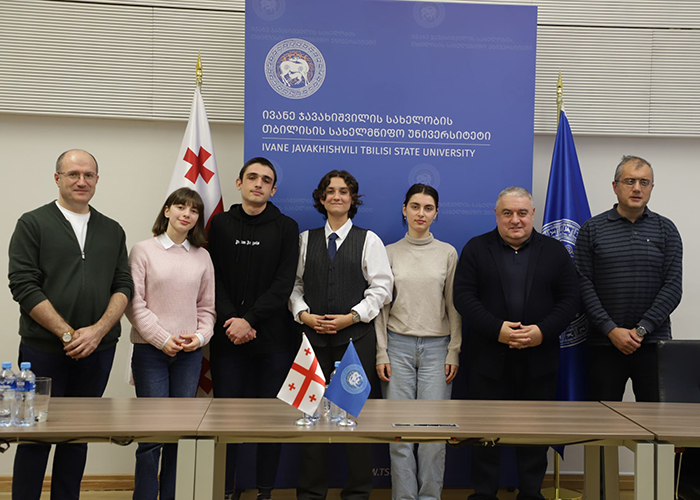 The Rector of Tbilisi State University, Academician Jaba Samushia presented certificates of appreciation and university gifts to the members of the TSU team designated “Asterisk” who won NASA Space Apps Challenge Tbilisi 2024. The project, which was developed by TSU physics students, and which includes an analysis of geomagnetic storms, was submitted from Georgia to the NASA Space Apps Challenge international competition. It was selected as one of the top 10 percents of the participating teams worldwide.
The Rector of Tbilisi State University, Academician Jaba Samushia presented certificates of appreciation and university gifts to the members of the TSU team designated “Asterisk” who won NASA Space Apps Challenge Tbilisi 2024. The project, which was developed by TSU physics students, and which includes an analysis of geomagnetic storms, was submitted from Georgia to the NASA Space Apps Challenge international competition. It was selected as one of the top 10 percents of the participating teams worldwide.
On the initiative of Rector Jaba Samushia, students engaged in the NASA Space Apps Challenge Hackathon will be sent to CERN, the European Organization for Nuclear Research, where they will visit the world’s largest laboratory for elementary particle physics.
“These are the first steps in great science. Keep taking part in similar projects, do not lose your enthusiasm. The University will support you as much as possible. I am very happy to see young people taking part in major scientific endeavors. It is the university’s strategy to support young scientists,” Jaba Samushia addressed the students.
The NASA Space Apps Challenge Tbilisi 2024 hackathon hosted over 70 participants from across Georgia. The hackathon brought together students and graduates from a variety of academic disciplines, including exact and natural sciences, programming, engineering, design, data analytics, storytelling, and journalism. The members of the TSU team designated “Asterisk” (Latin for ‘little star’) are second-year students in the physics department of the Faculty of Exact and Natural Sciences: Mariam Aslamazishvili, Luka Kezua, Salome Dzigua and Sesili Berishvili (supervisor - Associate Professor Oleg Kharshiladze).
At the NASA Space Apps Challenge hackathon, the TSU team selected the challenge: “Show Us What the May 2024 Geomagnetic Storm Looked Like.” In the countrywide competition, the TSU team emerged victorious, securing the top position and advancing to the subsequent phase. In the second stage of the global competition, the top 10% of submissions were selected, including “Asterisk.” The winner of the NASA Space Apps Challenge 2024 will be announced on January 16.
“We selected a challenge that addressed the analysis of geomagnetic storms, with a particular focus on the event that occurred in May 2024. The objective was to present an analysis of this process from the perspective of physicists. We have developed a web application that is both interesting and pedagogically valuable. It encompasses information regarding the nature of a geomagnetic storm, in addition to a direct analysis of a geomagnetic storm,” said Mariam Aslamazishvili, a member of “Asterisk,” said a student of the Faculty of Exact and Natural Sciences of TSU.
The largest hackathon of NASA (National Aeronautics and Space Administration in the USA) — NASA Space Apps Challenge, has been held annually on the first week of October since 2012. It brings together individuals with diverse professional backgrounds who are interested in space-related topics in approximately 300 cities across the globe. Annually, the hackathon attracts tens of thousands of participants, who collaborate in teams to identify practical solutions to the most pressing challenges on Earth and in space within a 48-hour timeframe. The primary objective of the hackathon is to utilize the data accumulated by NASA over several decades and to facilitate educational initiatives.

 FACULTY OF EXACT AND NATURAL SCIENCES
FACULTY OF EXACT AND NATURAL SCIENCES
 FACULTY OF HUMANITIES
FACULTY OF HUMANITIES
 FACULTY OF SOCIAL AND POLITICAL SCIENCES
FACULTY OF SOCIAL AND POLITICAL SCIENCES
 FACULTY OF PSYCHOLOGY AND EDUCATIONAL SCIENCES
FACULTY OF PSYCHOLOGY AND EDUCATIONAL SCIENCES
 FACULTY OF ECONOMICS AND BUSINESS
FACULTY OF ECONOMICS AND BUSINESS
 FACULTY OF MEDICINE
FACULTY OF MEDICINE
 FACULTY OF LAW
FACULTY OF LAW



